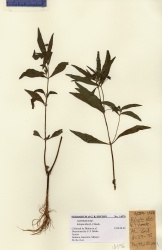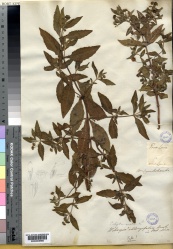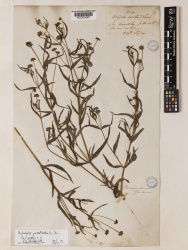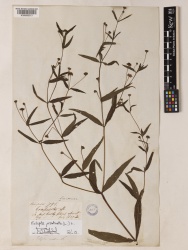Eclipta prostrata (aerial parts)
(Various title corrections) |
(Botanical Voucher Kew added) |
||
| (2 intermediate revisions by 2 users not shown) | |||
| Line 1: | Line 1: | ||
| − | {{DISPLAYTITLE:''Eclipta prostrata'' (aerial parts) }} | + | {{DISPLAYTITLE:''Eclipta prostrata'' (aerial parts) }} {{askbox|herb=''Eclipta prostrata''}} |
=Nomenclature= | =Nomenclature= | ||
| Line 13: | Line 13: | ||
=Botanical Voucher Specimen= | =Botanical Voucher Specimen= | ||
| + | |||
| + | {{Media4 |cat=Voucher | ||
| + | |||
| + | | source=MOBOT, Tropicos.org | ||
| + | | mainimage=Eclipta prostrata Tropicos 100011452.jpg | ||
| + | | companyimage=TropicosLogo.gif | ||
| + | | companyURL=http://www.tropicos.org/Image/100011452 | ||
| + | | reference=Tropicos.org. Missouri Botanical Garden. 21 Mar 2014 <http://www.tropicos.org/Image/100011452> | ||
| + | |||
| + | | companyimage2=Kewlogo.gif | ||
| + | | companyURL2=http://specimens.kew.org/herbarium/K000009860 | ||
| + | | image2=Eclipta_prostrata_Kew_imageBarcode=K000009860_24996.jpg | ||
| + | | source2=Royal Botanic Gardens, Kew. | ||
| + | |||
| + | | companyimage3=Kewlogo.gif | ||
| + | | companyURL3=http://specimens.kew.org/herbarium/K000054367 | ||
| + | | image3=Eclipta_prostrata_Kew_imageBarcode=K000054367_610427.jpg | ||
| + | | source3=Royal Botanic Gardens, Kew. | ||
| + | |||
| + | | companyimage4=Kewlogo.gif | ||
| + | | companyURL4=http://specimens.kew.org/herbarium/K000895513 | ||
| + | | image4=Eclipta_prostrata_Kew_imageBarcode=K000895513_610722.jpg | ||
| + | | source4=Royal Botanic Gardens, Kew. | ||
| + | |||
| + | |||
| + | | }} | ||
| + | |||
| + | |||
=Organoleptic Characteristics= | =Organoleptic Characteristics= | ||
Latest revision as of 00:32, 19 August 2014
Contents |
Nomenclature
Eclipta prostrata (L.) L. Asteraceae
Syn. Eclipta alba (L.) Hassk.
Standardized common name (English): eclipta
Ayurvedic name(s): bhringaraja
Pinyin name(s): li chang; mo han lian (aboveground parts)
Botanical Voucher Specimen
 |
 |
 |
|
|
|
|
|
|
Organoleptic Characteristics
Macroscopic Characteristics
Microscopic Characteristics
High Performance Thin Layer Chromatographic Identification
|
False daisy herb, mo han lian (aerial parts) (Eclipta prostrata) Lane Assignments Lanes, from left to right (Track, Volume, Sample):
Reference Sample(s) Reference: Dissolve 1 mg of quercetin and 1 mg of rosmarinic acid in 1 mL of methanol. Optional: dissolve 1 mg of wedelolactone in 1 mL of methanol. Stationary Phase Stationary phase, i.e. Silica gel 60, F254 Mobile Phase Toluene, acetone, formic acid 11:6:1 (v/v/v) Sample Preparation Method Sample: Mix 500 mg of powdered sample with 5 mL of methanol and sonicate for 10 minutes at 60°C, then centrifuge or filter the solutions and use the supernatants / filtrates as test solutions. Derivatization reagent: 1.) NP reagent, Preparation: 1 g of natural products reagent in 200 mL of ethyl acetate; 2.) PEG reagent, Preparation: 10 g of polyethylene glycol 400 in 200 mL of dichloromethane, Use: Heat plate 3 min at 100°C, dip (time 0, speed 5) in NP reagent, dry and dip (time 0, speed 5) in PEG reagent Detection Method Saturated chamber; developing distance 70 mm from lower edge; relative humidity 33% Other Notes Images presented in this entry are examples and are not intended to be used as basis for setting specifications for quality control purposes. System suitability test: Quercetin: orange fluorescent zone at Rf ~ 0.48; Rosmarinic acid: blue fluorescent zone at Rf ~ 0.27. Identification: Compare result with reference images. The fingerprint of the test solution is similar to that of the corresponding botanical reference sample. Additional weak zones may be present. The chromatogram of the test solution shows several blue white or greenish white zones just above the start position. There is a faint blue white zone below the position of reference quercetin and a blue white zone (wedelolactone) at the position of quercetin. Above it there is a pale blue zone. Above this zone, just below the solvent front, there is a pattern of three diffuse zones, a greenish, a blue violet and a red zone. Test for adulteration: No blue white zones are seen at the position of quercetin and just below it (between Rf ~ 0.37-0.47) (purple arrow, Great John’s wort herb).
|
Supplementary Information
Sources
- ↑ MOBOT, Tropicos.org http://www.tropicos.org/Image/100011452
- ↑ Royal Botanic Gardens, Kew. http://specimens.kew.org/herbarium/K000009860
- ↑ Royal Botanic Gardens, Kew. http://specimens.kew.org/herbarium/K000054367
- ↑ Royal Botanic Gardens, Kew. http://specimens.kew.org/herbarium/K000895513
- ↑ HPTLC Association http://www.hptlc-association.org/




